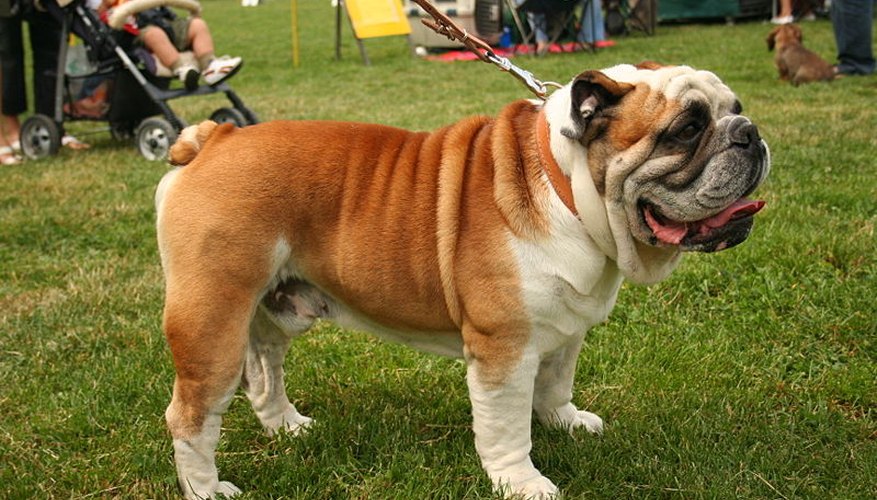Female English bulldogs require extra care when they become pregnant (they're called dams once they're pregnant).
Since some dames possess narrow birth canals that can lead to complications, it is important for you as an owner to play an active part in the pregnancy process and consult with your veterinarian if any problems arise. With careful attention and vigilance, your dam can have a healthy pregnancy and delivery.
- Female English bulldogs require extra care when they become pregnant (they're called dams once they're pregnant).
- Since some dames possess narrow birth canals that can lead to complications, it is important for you as an owner to play an active part in the pregnancy process and consult with your veterinarian if any problems arise.
Take your dog to the veterinarian. When you suspect your dam is pregnant, take her to the veterinarian to confirm your suspicions and to determine how far along she is. (English bulldog pregnancies usually last 9 weeks.) While you are at the vet's office, be sure to talk to your veterinarian about a natural birth or a C-section for your dog. Since some dams have trouble delivering, your dog may need to undergo a C-section to ensure the health of her puppies and herself. Consult with your veterinarian for the best choice to follow.
Maintain your dam's regular diet and schedule during the first 5 weeks of pregnancy. An English bulldog may experience stress if her routine is altered, which may negatively affect her pregnancy. Feed your dog the same brand and same amount of food as you did prior to her pregnancy. Do not increase her food intake at this time since too much weight gain may cause the puppies to grow too large. Also, do not give your dog extra vitamins or supplements unless your veterinarian advises otherwise. Excessive amounts of vitamin A or D can lead to birth defects.
- Maintain your dam's regular diet and schedule during the first 5 weeks of pregnancy.
- Do not increase her food intake at this time since too much weight gain may cause the puppies to grow too large.
Be sure your dog receives regular exercise during these weeks. Take her on a walk once a day to prevent her from gaining too much weight.
Increase your dog's food intake by 25 per cent during the sixth week to support the growing puppies and encourage milk production. Increase the food little by little throughout the week, until you reach an added 25 per cent of food. In the seventh week, increase your dam's food intake by another 25 per cent. Again, add the food little by little throughout the week. By the end of week seven, your dog should be eating 1 1/2 times the amount of food she was eating during the first 5 weeks of pregnancy. (Your dam should have her food split into two meals per day.)
- Increase your dog's food intake by 25 per cent during the sixth week to support the growing puppies and encourage milk production.
Divide your dog's food into three meals a day to avoid bloating after the seventh week. At this time, you should also prepare a whelping (birthing) box for your dam. Use a large shallow box or a plastic kiddie pool as the whelping area. Line the bottom of the box with disposable diapers; the absorbent side should be facing upwards. Then, lay clean towels on top of the diapers. Put the box in a quiet, warm and dry place in your home. Place a space heater or heat lamp close to the box since the puppies will need to stay warm (around 29.4 degrees C). Introduce your dog to the box and give her time to get used to it.
Watch your dog for signs of labour. Your dam can give birth any time between day 59 to day 65 of her pregnancy. During this time, carefully monitor her for signs of upcoming labour, such as frequent urination, panting, vomiting or shivering. She may look uncomfortable or nervous and may scratch at blankets in an effort to nest.
Take your dog's temperature. When your dam begins to show signs of upcoming labour, use a rectal thermometer to take her temperature two or three times a day. Your dog's temperature should drop from a normal 38.6 degrees C to 37.2 degrees C about 12 to 24 hours before labour starts. Once the temperature drops, make sure you or a family member will be home for the next 24 hours to monitor your dog's labour and pregnancy.
- Watch your dog for signs of labour.
- Once the temperature drops, make sure you or a family member will be home for the next 24 hours to monitor your dog's labour and pregnancy.
Monitor your dog during the delivery. Do not leave your dam's side once she starts giving birth to her puppies. Your dog should be able to handle the delivery on her own, but call your vet immediately if she is unable to pass a puppy within an hour.
TIP
If your English bulldog has hook worm or roundworms, she may infect her puppies. Take your bulldog to the veterinarian for the administration of a safe dewormer. If you opt for a natural birth, ask your vet to find out how many puppies will be in the litter. You should know this information to ensure all the puppies are accounted for during the delivery.
WARNING
Try not to breed your dam every season, especially if she has had a C-section to deliver her puppies. (English bulldogs come into season about every 6 to 8 months.) Give your dam the proper time to recover from her pregnancy and do not breed her more than once every year. Do not use any flea treatments on your pregnant dam since they can lead to serious complications during the pregnancy. Instead, use flea comb to remove the fleas.
